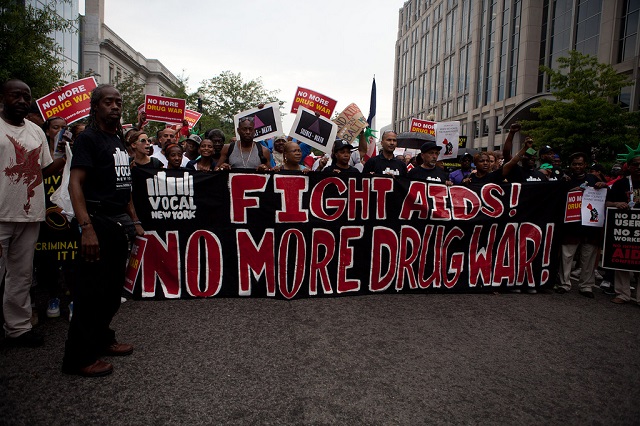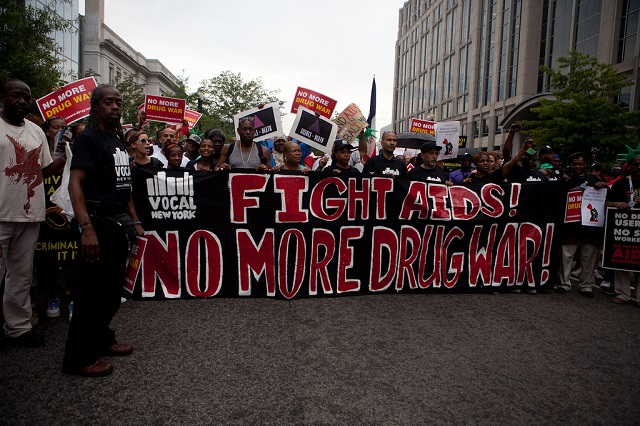
 As opposition to Trumpism rekindles the necessity of doing politics at the local and state levels, it’s important to note that reactionary ideas gestate at the local level before they get nationalized. And, with enough organizing, so too might emancipatory ones. (Photo: VOCAL-NY / Flickr)
As opposition to Trumpism rekindles the necessity of doing politics at the local and state levels, it’s important to note that reactionary ideas gestate at the local level before they get nationalized. And, with enough organizing, so too might emancipatory ones. (Photo: VOCAL-NY / Flickr)
Getting Tough: Welfare and Imprisonment in 1970s America, Julilly Kohler-Hausmann, Princeton University Press, 2017
Opponents of the US prison-industrial complex have long insisted that the problem is bigger than the unprecedented number of people this country locks up. The problem is how much the criminal legal system penetrates the lives of the most marginalized members of society — and how much it pervades the logic of the country as a whole. For critics of this vast carceral power, the challenge remains not only in undoing decades of public policy, but also in supplanting even more deeply rooted political logics that justify putting people in cages or otherwise violating and abusing them.
This tendency has often been summarized as “law and order,” referencing the language that conservative politicians from Barry Goldwater to Donald Trump have used in rallying for repression. Yet such phrasing misses a crucial component of what led this country to be so punitive: politicians did not just crack down on “crime” — they cracked down on whole communities. Criminalization did not just send more people to prison; it resulted in a wholesale exclusion of working-class communities of color from claims to citizenship.
In Getting Tough: Welfare and Imprisonment in 1970s America, historian Julilly Kohler-Hausmann examines the two foundational realms of this crackdown. The ethos of “getting tough” was an article of faith among the New Right at that time. The same impulse that led Nelson Rockefeller to implement the harshest drug laws in the country in 1971 New York — including a proposal that all drug dealers get life sentences — also prompted Ronald Reagan to criminalize welfare recipients through a combination of surveillance, prosecuting alleged fraud, and massive reductions to the number of people able to receive welfare. Both men used such presumed toughness as evidence of their credentials for the presidency. Reagan succeeded in that effort in 1980, and used his popularity to advance an era of excessive spending on security and punishment alongside steep cuts to the programs that keep people healthy, educated and safe.
Kohler-Hausmann focuses on three case studies: the Rockefeller Drug Laws in New York, criminalization of welfare and attacks on “welfare fraud” in California and Illinois, and sentencing reform in California. Getting Tough is policy history, but it incorporates a keen awareness of how social movements and other grassroots responses influence elites — and not always in ways that the activists themselves may want. One of the book’s strengths is its attention to the letters Reagan, Rockefeller and other politicians received urging them to get tough: to get rid of drugs and drug dealers, to end “welfare fraud,” to not go easy on “criminals.” Kohler-Hausmann is careful to show that this kind of populist conservatism was cynically managed — at times even curated — by elites to pursue their own ends. The more Ronald Reagan railed against “welfare fraud,” for instance, the more letters he received complaining about that very topic. He then used those letters as evidence of public support for his austerity programs.
Yet, constituent letters were not always so solicited. As drug use rose in the 1960s, many people asked their elected officials to do something. There is a big difference between something and degrading punishment, however, and Kohler-Hausmann pays close attention to how elites channeled certain popular demands toward reactionary ends. While such letters show that elites had some support for increasingly punitive policies, they do not at all suggest that people — particularly Black people — wanted mass incarceration. Rather, they show how politicians bend public opinion to their will.
Letters were not the only way people made their voices heard. In the book’s final section, Kohler-Hausmann profiles the campaign against California’s indeterminate sentencing. A centerpiece of how prisons ostensibly aimed to “rehabilitate” their wards, indeterminate sentences equipped the parole board with authority to decide when an incarcerated person had reformed into a “good citizen.” The policy came under assault from current and former prisoners, including the California Prisoners’ Rights Union, which pointed out how it was used to punish dissidents: those who protested prison conditions or objected to state-enforced therapies were denied parole indefinitely. “They want prisoners who are conformists, whose spirits have been broken,” a prisoner reported. “What they can’t take is a man with pride.” Conservatives opposed it, meanwhile, for being insufficiently tough. Kohler-Hausmann extensively profiles how grassroots campaigns tangled with the state and right-wing opposition. Even though the struggle ended in greater punishment, it was not a foregone conclusion. As with drugs and welfare, criminal sentencing policy was up for grabs in the 1970s.
In each case, getting tough won out in part because the previous approach had failed. Kohler-Hausmann shows how punitive and racist the “pre-tough” era was and how limited the “rehabilitation” framework always was. She tracks, for instance, the drug treatment programs Rockefeller championed prior to his prohibitionist turn. Like the intensive criminalization that followed, the state’s medicalized response to drug use in the 1960s “saw addiction as an individual pathology, located in a person’s biology or personality,” she writes. “Both [criminalization and medicalization] assumed that public institutions beyond the family or social network should be enlisted in encouraging sobriety and abstinence.” And both involved involuntary commitment to state institutions to exert their will. Likewise, even before the massive constriction of welfare, such programs placed strict surveillance upon the purchasing habits and sexual choices of welfare recipients. As a result, conservative ideas rose to the surface in both parties. Getting tough was a bipartisan project that mostly benefitted Republicans. Neither party cared, in any substantive fashion, for what people who sold or used drugs, received welfare, or were incarcerated, thought about public policy. Both parties operated from a perspective that assumed such people would be excluded, guaranteeing that they would be. Getting tough won “mostly because they marshaled vast social, economic, and cultural resources that were largely unavailable to prisoners and their allies,” Kohler-Hausmann writes.
Rallying against the “school to prison pipeline,” activists have done a remarkable job of highlighting how criminalization informs education funding, curriculum and disciplinary practices that send poor and working-class kids of color to jail and prison. Yet, few have been as attentive to what connects welfare and imprisonment. Kohler-Hausmann helps us understand why we need to talk about both as inextricably connected systems. In both arenas, “getting tough” served to exclude people from society. “Enacting and implementing tough policy was part of renegotiating the terms of citizenship during the 1960s and 1970s as much as was the legislation and court rulings that expanded civil rights,” she writes. At stake is more than a proper understanding of how the carceral state got to be so vast, necessary as that understanding may be. Also at stake is recognizing the scale of the carceral state itself: the knowledge that criminalization and exclusion define US society in ways that far exceed imprisonment. Long a bastion of conservative thought, get-tough politics won out as policy when the failings of liberal institutions gave out under pressure from both the left and the right.
Grasping the scale of exclusionary politics helps plot their undoing. As opposition to Trumpism rekindles the necessity of doing politics at the local and state levels, Getting Tough is a vital reminder that reactionary ideas gestate at the local level before they get nationalized. And, with enough organizing, so too might emancipatory ones.
Join us in defending the truth before it’s too late
The future of independent journalism is uncertain, and the consequences of losing it are too grave to ignore. To ensure Truthout remains safe, strong, and free, we need to raise $41,000 in the next 5 days. Every dollar raised goes directly toward the costs of producing news you can trust.
Please give what you can — because by supporting us with a tax-deductible donation, you’re not just preserving a source of news, you’re helping to safeguard what’s left of our democracy.